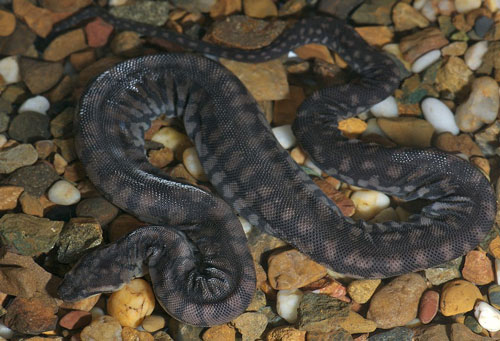Description:
Captive Housing: Housing can be challenging, and successful husbandry of these very cool animals is sometimes problematic. Tank size depends on the size of the snake. You can house smaller specimens (up to 20 inches) in 10- to 15-gallon tanks. These animals can and will escape, so a screen top is recommended. Larger specimens, of course, need larger tanks, up to 150 gallons or more for really large individuals. Fill the tank about three-fourths with dechlorinated water. Put a fully submersible water heater at the bottom to keep the water between 84 to 86 degrees Fahrenheit. I don’t recommend gravel or sand at the bottom of the tank, as it just adds to the cleaning chore, and it is more than likely not needed by the snake. A PH of 5 seems to be best for trunk snakes, but this is often open to debate. Making these snakes feel secure is a must. Place a hide in the water, something that won’t float. Ceramic pots and commercial snake hides heavy enough to not float work well. Mopani wood is also great. It also adds tannic acid to the water, giving it that brownish look that these snakes seem to find so comfortable. Cork bark is also a nice addition. It floats, leaches brown into the water and can be used as a basking site if the snake chooses to use it. Same with the Mopani wood if it’s sticking out of the water. Live or fake aquatic plants finish off the tank. The snake will use the plants as its hunting grounds. A low-level UVB lamp should be used over the tank with a 12-hour-on-12-hour-off photo period. Diet: These carnivores feed on fish and amphibians, such as frogs. They don’t seem to have a fish preference. Some will take dead fish, but only some. Live feeder fish can be maintained in the tank for a constant supply of food. An all-fish diet seems fine. I’d just skip the frogs. What’s Available: Not commonly sold, but can be found at specialty reptile stores, rarely at reptile shows and sometimes on the Internet. About 99 percent are imported from Indonesia. Captive breeding is rare to nonexistent. Gravid females are sometimes imported, and babies sometimes result, but that’s about it. Most imports are young, stressed and have been roughly treated. They’ve usually been subjected to poor water quality and poor temperatures. Most arrive with a white fungus on the skin. There are many treatments for this fungus, from commercial fungus treatment meant for fish to changing the PH of the water. Some advocate just proper husbandry and the ailment will cure itself. I’ve found that the fungus is hard to deal with and usually results in the death of the snake. Or it could be the stress. Hard to say. Verdict: Tough to keep. They are easily stressed and come in poor condition. If you can acquire a healthy animal and set it up in the proper captive habitat, they might thrive. I tend to lose more than one would expect, but at the same time, I have had many clients excel at keeping them for many years. I don’t recommend this as a beginner snake. Speedy Strike: These ambush predators will remain motionless for long periods of time, hanging out in vegetation, waiting for a fish to swim within range of its quick strike.
Habitat:
Usually found in streams, ponds and lagoons near coasts. Lives in both fresh and brackish waters.
Range:
Northern Sumatra and around the west coast of Malaysia
Scientific Name: Acrochordus javanicus
Species Group:
Family: Acrochordidae
Size:
Level: advanced
Weight:
Dangerous: No


